Business Environmental Analysis Report: HND Business, Unit 1
VerifiedAdded on 2022/03/11
|24
|6370
|33
Report
AI Summary
This report provides a comprehensive analysis of the business environment, encompassing various types of organizations including private, public, and voluntary sectors. It explores different legal structures such as sole proprietorships, partnerships, and corporations, providing insights into their characteristics and implications. The report includes detailed case studies of Petronas, Dahmakan, and Mercy Malaysia, examining their vision, mission, services, and organizational structures. Furthermore, it delves into the positive and negative impacts of the macro environment on IKEA, along with an analysis of market structures influencing pricing and output decisions. The report also features SWOT and PESTLE analyses, and explores internal and external factors affecting IKEA, identifying its strengths and weaknesses, and how macro and micro factors impact business objectives and decision-making. The interrelationships between human resource management and marketing are also discussed. The document aims to provide a detailed overview of business environmental analysis, offering practical applications and insights for business students.
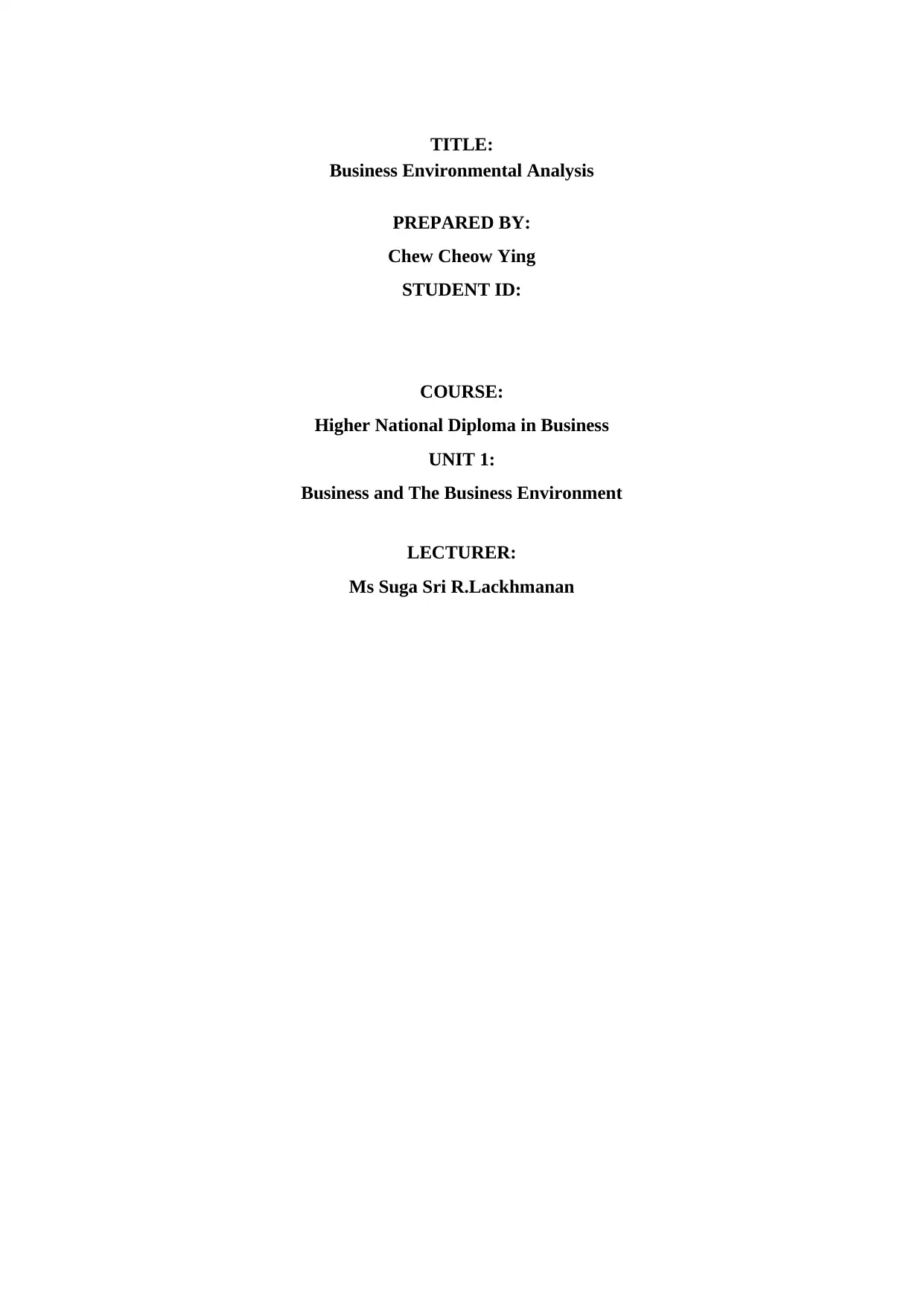
TITLE:
Business Environmental Analysis
PREPARED BY:
Chew Cheow Ying
STUDENT ID:
COURSE:
Higher National Diploma in Business
UNIT 1:
Business and The Business Environment
LECTURER:
Ms Suga Sri R.Lackhmanan
Business Environmental Analysis
PREPARED BY:
Chew Cheow Ying
STUDENT ID:
COURSE:
Higher National Diploma in Business
UNIT 1:
Business and The Business Environment
LECTURER:
Ms Suga Sri R.Lackhmanan
Paraphrase This Document
Need a fresh take? Get an instant paraphrase of this document with our AI Paraphraser
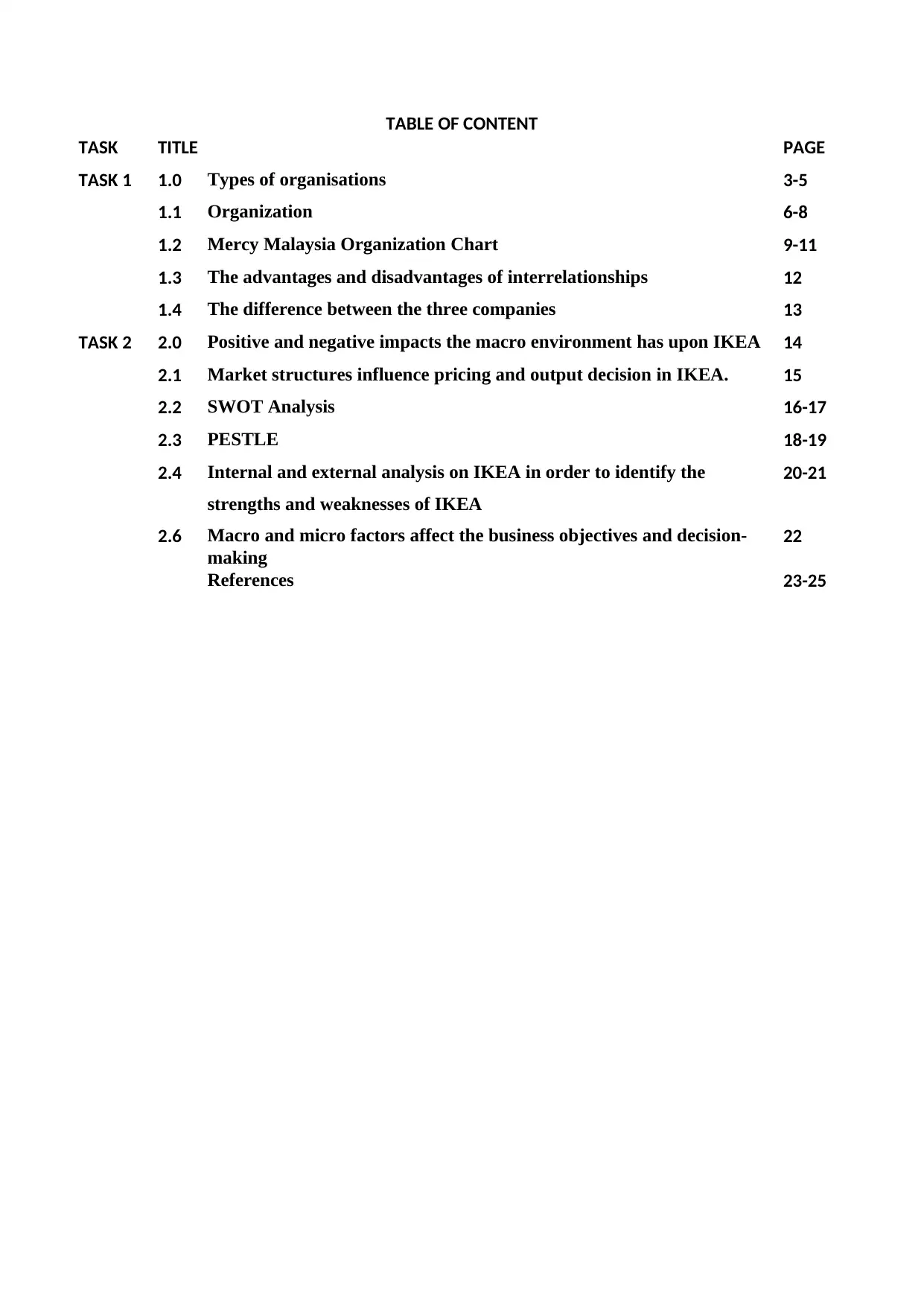
TABLE OF CONTENT
TASK TITLE PAGE
TASK 1 1.0 Types of organisations 3-5
1.1 Organization 6-8
1.2 Mercy Malaysia Organization Chart 9-11
1.3 The advantages and disadvantages of interrelationships 12
1.4 The difference between the three companies 13
TASK 2 2.0 Positive and negative impacts the macro environment has upon IKEA 14
2.1 Market structures influence pricing and output decision in IKEA. 15
2.2 SWOT Analysis 16-17
2.3 PESTLE 18-19
2.4 Internal and external analysis on IKEA in order to identify the
strengths and weaknesses of IKEA
20-21
2.6 Macro and micro factors affect the business objectives and decision-
making
22
References 23-25
TASK TITLE PAGE
TASK 1 1.0 Types of organisations 3-5
1.1 Organization 6-8
1.2 Mercy Malaysia Organization Chart 9-11
1.3 The advantages and disadvantages of interrelationships 12
1.4 The difference between the three companies 13
TASK 2 2.0 Positive and negative impacts the macro environment has upon IKEA 14
2.1 Market structures influence pricing and output decision in IKEA. 15
2.2 SWOT Analysis 16-17
2.3 PESTLE 18-19
2.4 Internal and external analysis on IKEA in order to identify the
strengths and weaknesses of IKEA
20-21
2.6 Macro and micro factors affect the business objectives and decision-
making
22
References 23-25
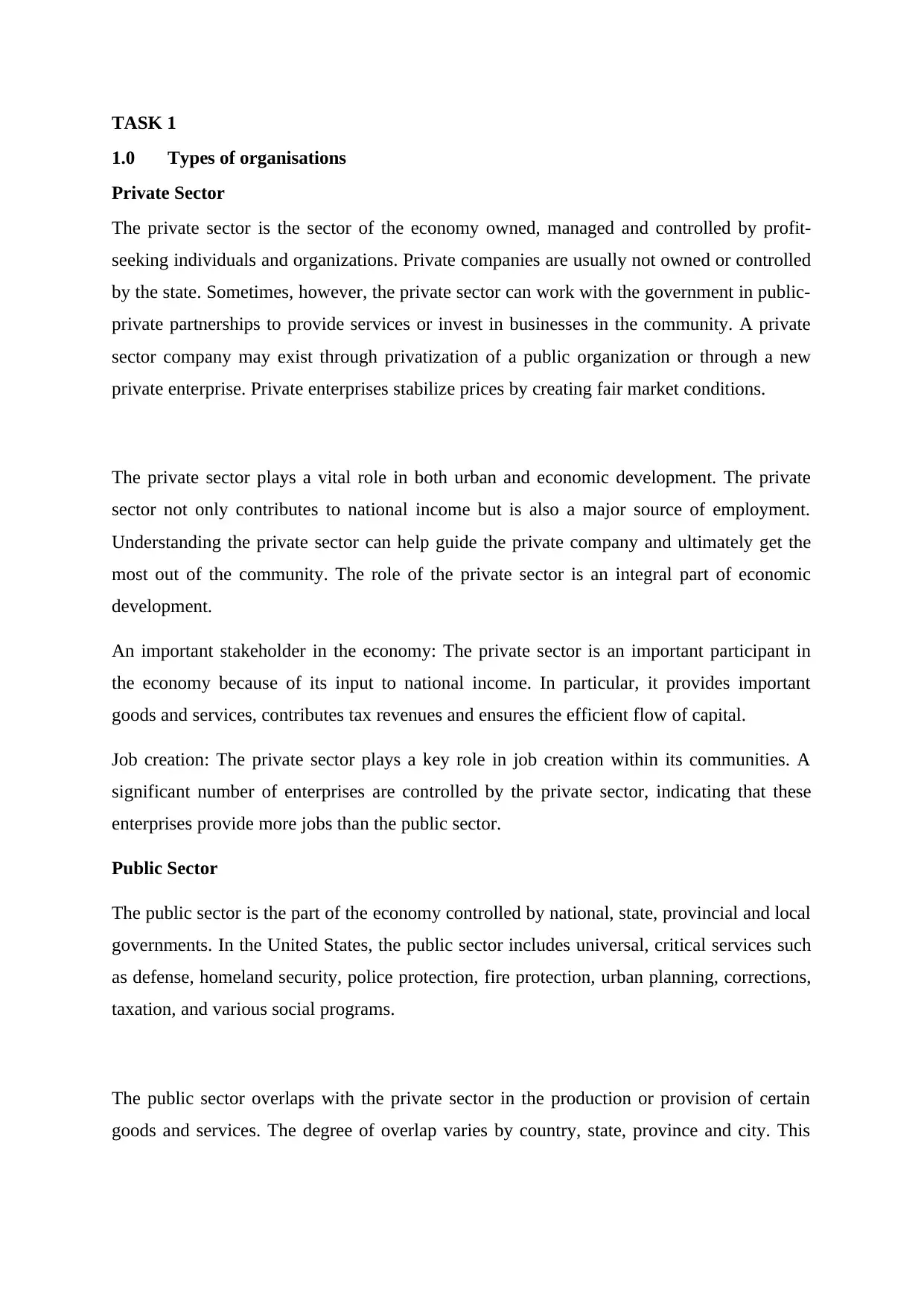
TASK 1
1.0 Types of organisations
Private Sector
The private sector is the sector of the economy owned, managed and controlled by profit-
seeking individuals and organizations. Private companies are usually not owned or controlled
by the state. Sometimes, however, the private sector can work with the government in public-
private partnerships to provide services or invest in businesses in the community. A private
sector company may exist through privatization of a public organization or through a new
private enterprise. Private enterprises stabilize prices by creating fair market conditions.
The private sector plays a vital role in both urban and economic development. The private
sector not only contributes to national income but is also a major source of employment.
Understanding the private sector can help guide the private company and ultimately get the
most out of the community. The role of the private sector is an integral part of economic
development.
An important stakeholder in the economy: The private sector is an important participant in
the economy because of its input to national income. In particular, it provides important
goods and services, contributes tax revenues and ensures the efficient flow of capital.
Job creation: The private sector plays a key role in job creation within its communities. A
significant number of enterprises are controlled by the private sector, indicating that these
enterprises provide more jobs than the public sector.
Public Sector
The public sector is the part of the economy controlled by national, state, provincial and local
governments. In the United States, the public sector includes universal, critical services such
as defense, homeland security, police protection, fire protection, urban planning, corrections,
taxation, and various social programs.
The public sector overlaps with the private sector in the production or provision of certain
goods and services. The degree of overlap varies by country, state, province and city. This
1.0 Types of organisations
Private Sector
The private sector is the sector of the economy owned, managed and controlled by profit-
seeking individuals and organizations. Private companies are usually not owned or controlled
by the state. Sometimes, however, the private sector can work with the government in public-
private partnerships to provide services or invest in businesses in the community. A private
sector company may exist through privatization of a public organization or through a new
private enterprise. Private enterprises stabilize prices by creating fair market conditions.
The private sector plays a vital role in both urban and economic development. The private
sector not only contributes to national income but is also a major source of employment.
Understanding the private sector can help guide the private company and ultimately get the
most out of the community. The role of the private sector is an integral part of economic
development.
An important stakeholder in the economy: The private sector is an important participant in
the economy because of its input to national income. In particular, it provides important
goods and services, contributes tax revenues and ensures the efficient flow of capital.
Job creation: The private sector plays a key role in job creation within its communities. A
significant number of enterprises are controlled by the private sector, indicating that these
enterprises provide more jobs than the public sector.
Public Sector
The public sector is the part of the economy controlled by national, state, provincial and local
governments. In the United States, the public sector includes universal, critical services such
as defense, homeland security, police protection, fire protection, urban planning, corrections,
taxation, and various social programs.
The public sector overlaps with the private sector in the production or provision of certain
goods and services. The degree of overlap varies by country, state, province and city. This
⊘ This is a preview!⊘
Do you want full access?
Subscribe today to unlock all pages.

Trusted by 1+ million students worldwide
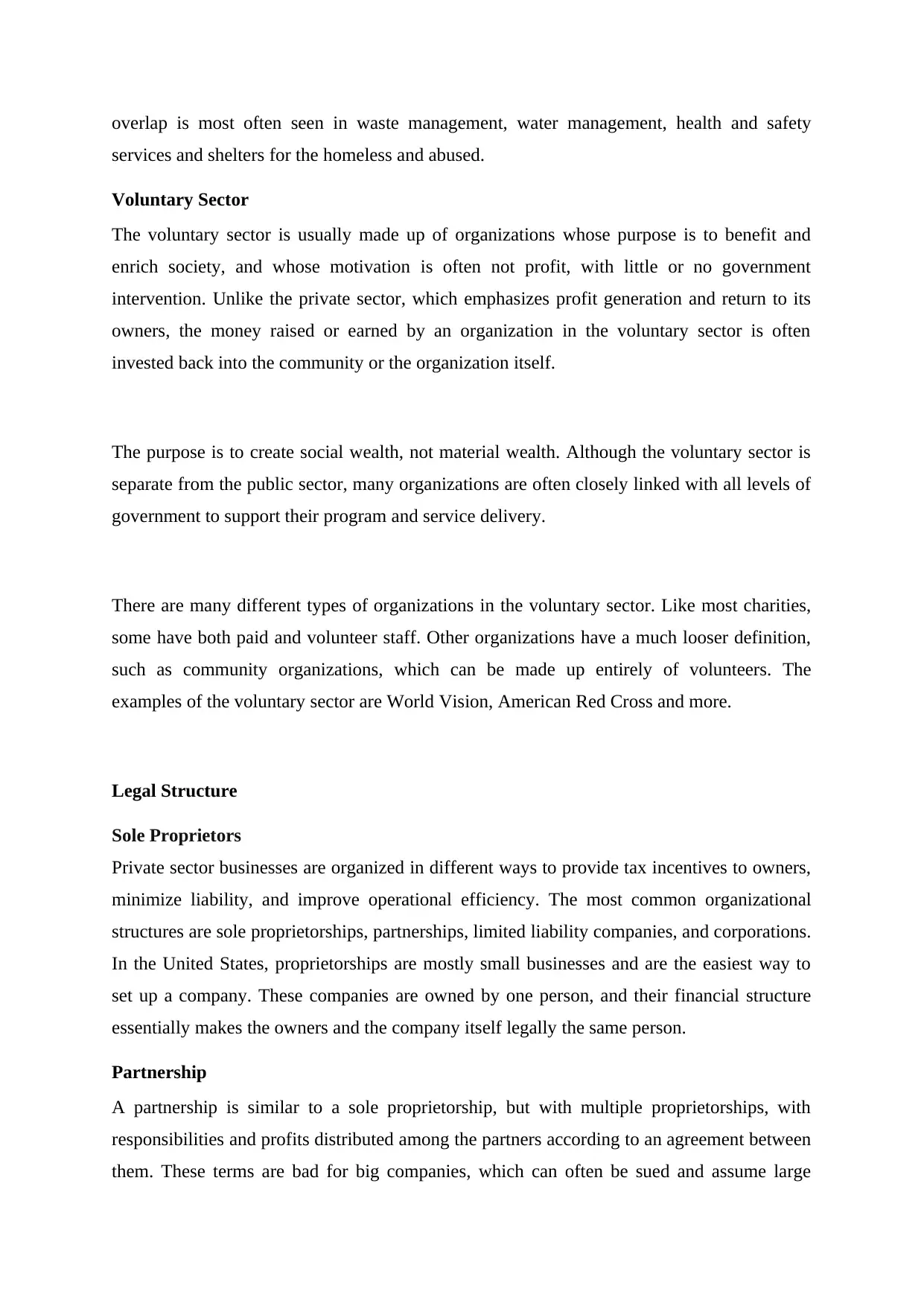
overlap is most often seen in waste management, water management, health and safety
services and shelters for the homeless and abused.
Voluntary Sector
The voluntary sector is usually made up of organizations whose purpose is to benefit and
enrich society, and whose motivation is often not profit, with little or no government
intervention. Unlike the private sector, which emphasizes profit generation and return to its
owners, the money raised or earned by an organization in the voluntary sector is often
invested back into the community or the organization itself.
The purpose is to create social wealth, not material wealth. Although the voluntary sector is
separate from the public sector, many organizations are often closely linked with all levels of
government to support their program and service delivery.
There are many different types of organizations in the voluntary sector. Like most charities,
some have both paid and volunteer staff. Other organizations have a much looser definition,
such as community organizations, which can be made up entirely of volunteers. The
examples of the voluntary sector are World Vision, American Red Cross and more.
Legal Structure
Sole Proprietors
Private sector businesses are organized in different ways to provide tax incentives to owners,
minimize liability, and improve operational efficiency. The most common organizational
structures are sole proprietorships, partnerships, limited liability companies, and corporations.
In the United States, proprietorships are mostly small businesses and are the easiest way to
set up a company. These companies are owned by one person, and their financial structure
essentially makes the owners and the company itself legally the same person.
Partnership
A partnership is similar to a sole proprietorship, but with multiple proprietorships, with
responsibilities and profits distributed among the partners according to an agreement between
them. These terms are bad for big companies, which can often be sued and assume large
services and shelters for the homeless and abused.
Voluntary Sector
The voluntary sector is usually made up of organizations whose purpose is to benefit and
enrich society, and whose motivation is often not profit, with little or no government
intervention. Unlike the private sector, which emphasizes profit generation and return to its
owners, the money raised or earned by an organization in the voluntary sector is often
invested back into the community or the organization itself.
The purpose is to create social wealth, not material wealth. Although the voluntary sector is
separate from the public sector, many organizations are often closely linked with all levels of
government to support their program and service delivery.
There are many different types of organizations in the voluntary sector. Like most charities,
some have both paid and volunteer staff. Other organizations have a much looser definition,
such as community organizations, which can be made up entirely of volunteers. The
examples of the voluntary sector are World Vision, American Red Cross and more.
Legal Structure
Sole Proprietors
Private sector businesses are organized in different ways to provide tax incentives to owners,
minimize liability, and improve operational efficiency. The most common organizational
structures are sole proprietorships, partnerships, limited liability companies, and corporations.
In the United States, proprietorships are mostly small businesses and are the easiest way to
set up a company. These companies are owned by one person, and their financial structure
essentially makes the owners and the company itself legally the same person.
Partnership
A partnership is similar to a sole proprietorship, but with multiple proprietorships, with
responsibilities and profits distributed among the partners according to an agreement between
them. These terms are bad for big companies, which can often be sued and assume large
Paraphrase This Document
Need a fresh take? Get an instant paraphrase of this document with our AI Paraphraser

amounts of loans and debt as a normal part of day-to-day business. For these reasons, large
companies often decide to organize differently to protect their owners.
Public limited Company
Much larger, this is another type of joint stock company, just like a private limited company,
where the company is a registered business, the shareholders are voted by the board of
directors on behalf of the shareholders and there is an A.G.M. on certain key issues about the
company.
The main difference between a limited company and a private limited company is that a
limited company can sell its shares to the public on the stock exchange and, therefore, can
raise more capital than a private limited company.
If a private limited company wishes to become a limited company, it must amend its
Memorandum and Articles of Association and resubmit them to the Registrar of
Companies.If the company is deemed to have acted legally and in the best interest of
shareholders, a new certificate of incorporation and a trading certificate will be issued, which
will allow the company to sell its shares on the stock exchange. The stock price will then
fluctuate depending on the investor's view of the PLC.
Generally, the owners (shareholders) of a corporation want the corporation to make as much
profit as possible, so that shareholders receive a very handsome dividend per share. However,
boards and management often want to devote part of PLC's resources to growth and
diversification (such as the launch of new products), which will conflict with shareholders'
desire to maximize profits. This is called a divorce of ownership and control.PLC must
publish its annual accounts, or disclose them, and is therefore highly susceptible to investors'
and bankers' perceptions of its progress and success. As a result, an LLC is also at risk of
being taken over by an outside agency if they manage to accumulate more than 50% of the
LLC's shares.
companies often decide to organize differently to protect their owners.
Public limited Company
Much larger, this is another type of joint stock company, just like a private limited company,
where the company is a registered business, the shareholders are voted by the board of
directors on behalf of the shareholders and there is an A.G.M. on certain key issues about the
company.
The main difference between a limited company and a private limited company is that a
limited company can sell its shares to the public on the stock exchange and, therefore, can
raise more capital than a private limited company.
If a private limited company wishes to become a limited company, it must amend its
Memorandum and Articles of Association and resubmit them to the Registrar of
Companies.If the company is deemed to have acted legally and in the best interest of
shareholders, a new certificate of incorporation and a trading certificate will be issued, which
will allow the company to sell its shares on the stock exchange. The stock price will then
fluctuate depending on the investor's view of the PLC.
Generally, the owners (shareholders) of a corporation want the corporation to make as much
profit as possible, so that shareholders receive a very handsome dividend per share. However,
boards and management often want to devote part of PLC's resources to growth and
diversification (such as the launch of new products), which will conflict with shareholders'
desire to maximize profits. This is called a divorce of ownership and control.PLC must
publish its annual accounts, or disclose them, and is therefore highly susceptible to investors'
and bankers' perceptions of its progress and success. As a result, an LLC is also at risk of
being taken over by an outside agency if they manage to accumulate more than 50% of the
LLC's shares.
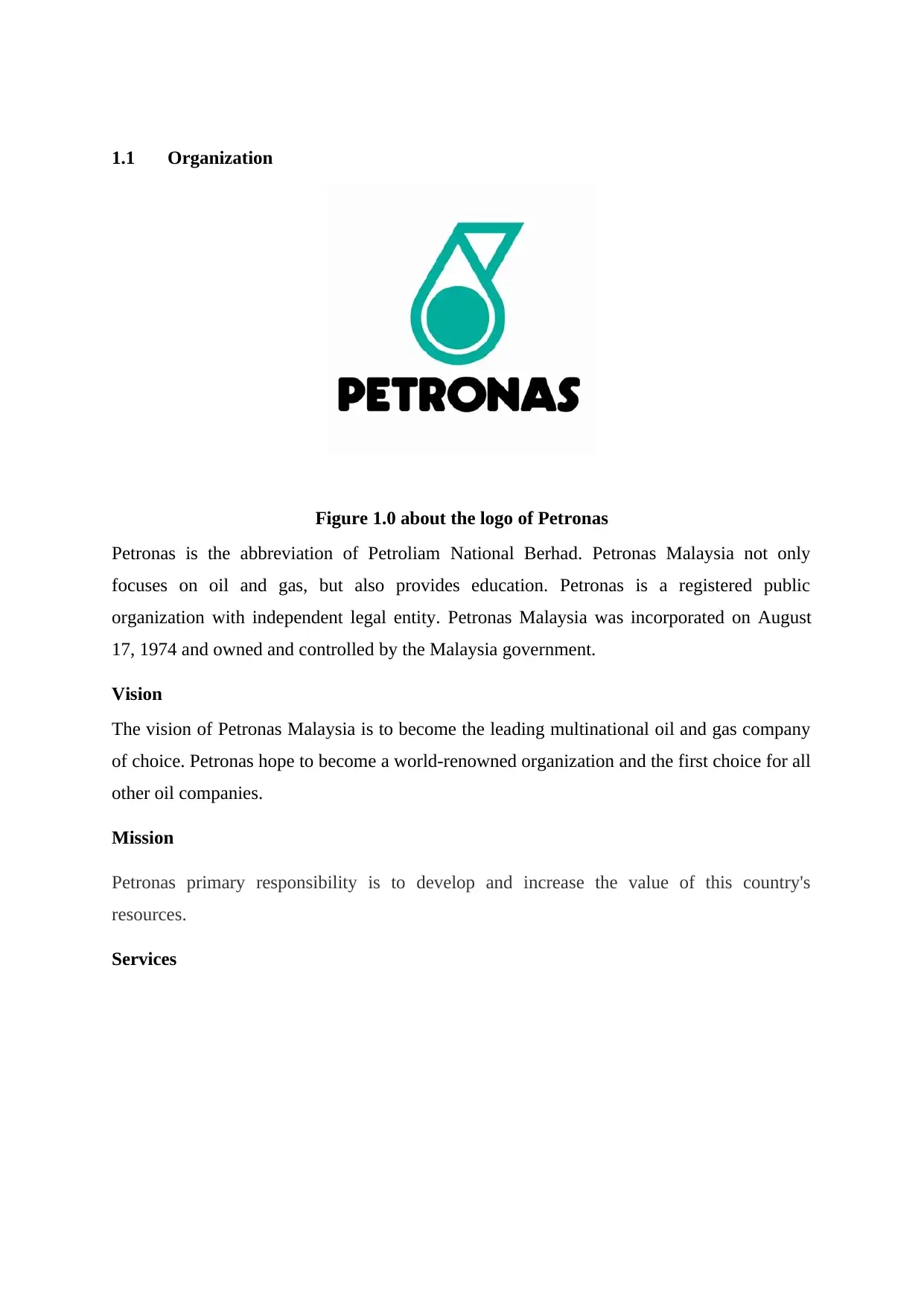
1.1 Organization
Figure 1.0 about the logo of Petronas
Petronas is the abbreviation of Petroliam National Berhad. Petronas Malaysia not only
focuses on oil and gas, but also provides education. Petronas is a registered public
organization with independent legal entity. Petronas Malaysia was incorporated on August
17, 1974 and owned and controlled by the Malaysia government.
Vision
The vision of Petronas Malaysia is to become the leading multinational oil and gas company
of choice. Petronas hope to become a world-renowned organization and the first choice for all
other oil companies.
Mission
Petronas primary responsibility is to develop and increase the value of this country's
resources.
Services
Figure 1.0 about the logo of Petronas
Petronas is the abbreviation of Petroliam National Berhad. Petronas Malaysia not only
focuses on oil and gas, but also provides education. Petronas is a registered public
organization with independent legal entity. Petronas Malaysia was incorporated on August
17, 1974 and owned and controlled by the Malaysia government.
Vision
The vision of Petronas Malaysia is to become the leading multinational oil and gas company
of choice. Petronas hope to become a world-renowned organization and the first choice for all
other oil companies.
Mission
Petronas primary responsibility is to develop and increase the value of this country's
resources.
Services
⊘ This is a preview!⊘
Do you want full access?
Subscribe today to unlock all pages.

Trusted by 1+ million students worldwide
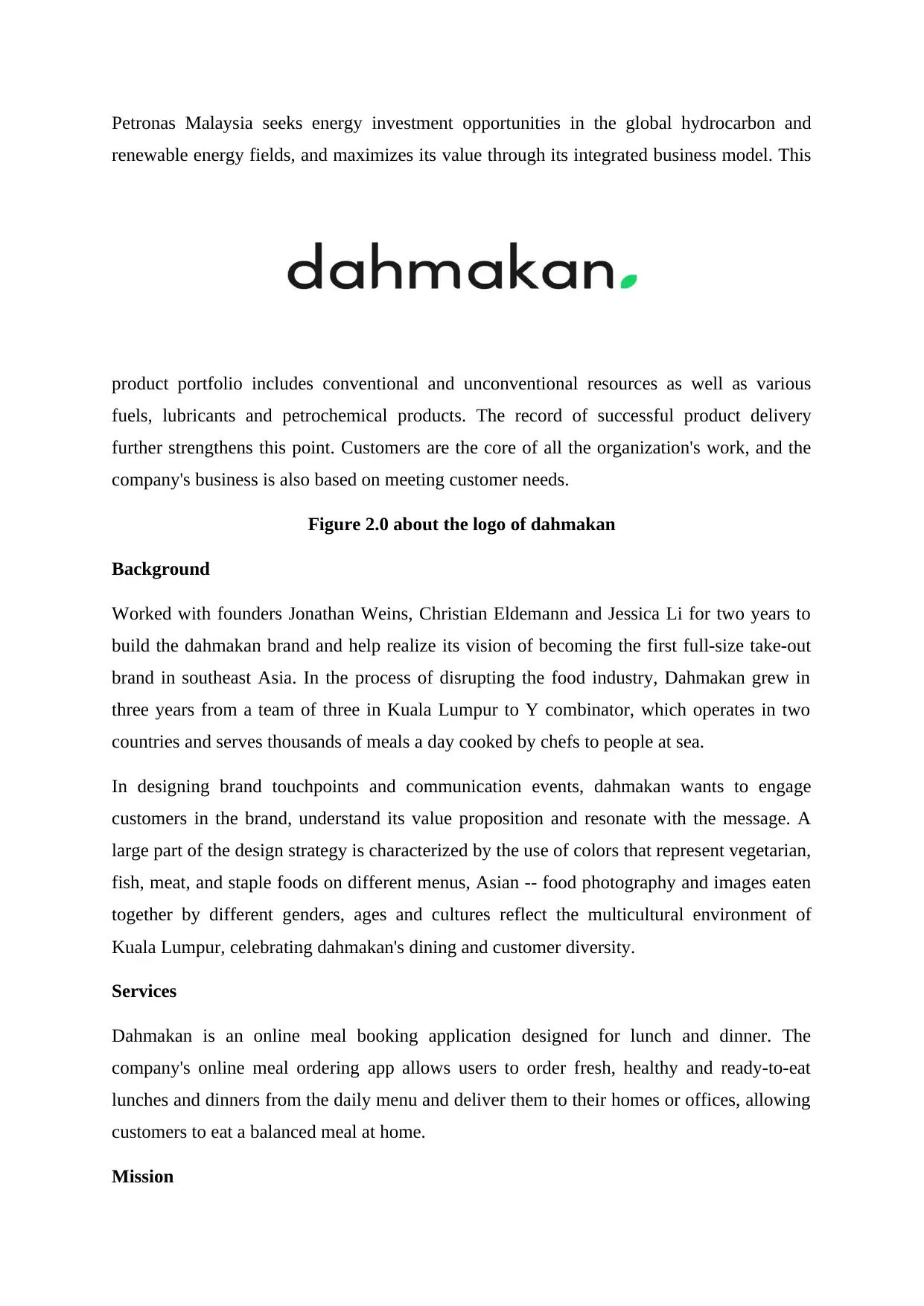
Petronas Malaysia seeks energy investment opportunities in the global hydrocarbon and
renewable energy fields, and maximizes its value through its integrated business model. This
product portfolio includes conventional and unconventional resources as well as various
fuels, lubricants and petrochemical products. The record of successful product delivery
further strengthens this point. Customers are the core of all the organization's work, and the
company's business is also based on meeting customer needs.
Figure 2.0 about the logo of dahmakan
Background
Worked with founders Jonathan Weins, Christian Eldemann and Jessica Li for two years to
build the dahmakan brand and help realize its vision of becoming the first full-size take-out
brand in southeast Asia. In the process of disrupting the food industry, Dahmakan grew in
three years from a team of three in Kuala Lumpur to Y combinator, which operates in two
countries and serves thousands of meals a day cooked by chefs to people at sea.
In designing brand touchpoints and communication events, dahmakan wants to engage
customers in the brand, understand its value proposition and resonate with the message. A
large part of the design strategy is characterized by the use of colors that represent vegetarian,
fish, meat, and staple foods on different menus, Asian -- food photography and images eaten
together by different genders, ages and cultures reflect the multicultural environment of
Kuala Lumpur, celebrating dahmakan's dining and customer diversity.
Services
Dahmakan is an online meal booking application designed for lunch and dinner. The
company's online meal ordering app allows users to order fresh, healthy and ready-to-eat
lunches and dinners from the daily menu and deliver them to their homes or offices, allowing
customers to eat a balanced meal at home.
Mission
renewable energy fields, and maximizes its value through its integrated business model. This
product portfolio includes conventional and unconventional resources as well as various
fuels, lubricants and petrochemical products. The record of successful product delivery
further strengthens this point. Customers are the core of all the organization's work, and the
company's business is also based on meeting customer needs.
Figure 2.0 about the logo of dahmakan
Background
Worked with founders Jonathan Weins, Christian Eldemann and Jessica Li for two years to
build the dahmakan brand and help realize its vision of becoming the first full-size take-out
brand in southeast Asia. In the process of disrupting the food industry, Dahmakan grew in
three years from a team of three in Kuala Lumpur to Y combinator, which operates in two
countries and serves thousands of meals a day cooked by chefs to people at sea.
In designing brand touchpoints and communication events, dahmakan wants to engage
customers in the brand, understand its value proposition and resonate with the message. A
large part of the design strategy is characterized by the use of colors that represent vegetarian,
fish, meat, and staple foods on different menus, Asian -- food photography and images eaten
together by different genders, ages and cultures reflect the multicultural environment of
Kuala Lumpur, celebrating dahmakan's dining and customer diversity.
Services
Dahmakan is an online meal booking application designed for lunch and dinner. The
company's online meal ordering app allows users to order fresh, healthy and ready-to-eat
lunches and dinners from the daily menu and deliver them to their homes or offices, allowing
customers to eat a balanced meal at home.
Mission
Paraphrase This Document
Need a fresh take? Get an instant paraphrase of this document with our AI Paraphraser
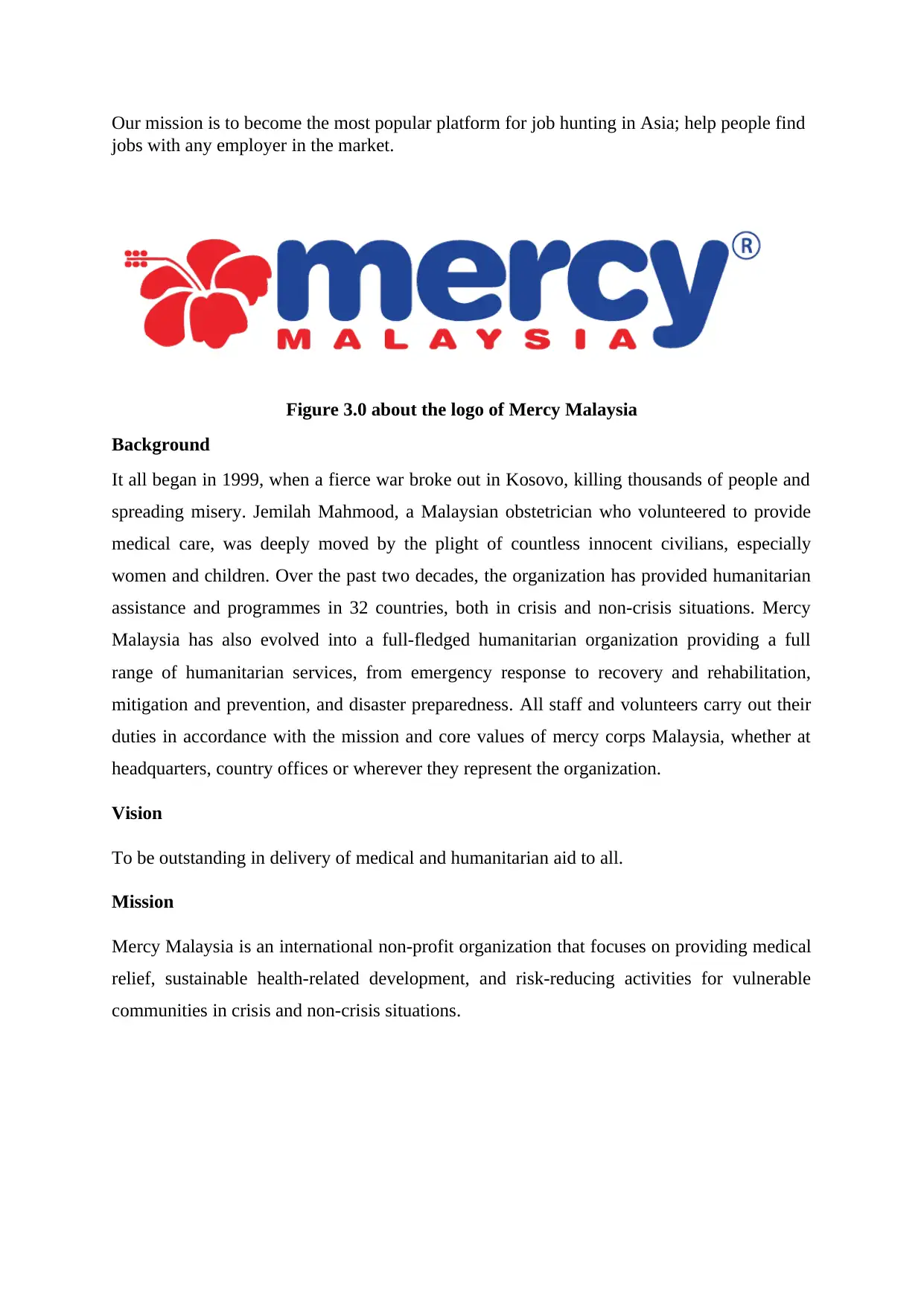
Our mission is to become the most popular platform for job hunting in Asia; help people find
jobs with any employer in the market.
Figure 3.0 about the logo of Mercy Malaysia
Background
It all began in 1999, when a fierce war broke out in Kosovo, killing thousands of people and
spreading misery. Jemilah Mahmood, a Malaysian obstetrician who volunteered to provide
medical care, was deeply moved by the plight of countless innocent civilians, especially
women and children. Over the past two decades, the organization has provided humanitarian
assistance and programmes in 32 countries, both in crisis and non-crisis situations. Mercy
Malaysia has also evolved into a full-fledged humanitarian organization providing a full
range of humanitarian services, from emergency response to recovery and rehabilitation,
mitigation and prevention, and disaster preparedness. All staff and volunteers carry out their
duties in accordance with the mission and core values of mercy corps Malaysia, whether at
headquarters, country offices or wherever they represent the organization.
Vision
To be outstanding in delivery of medical and humanitarian aid to all.
Mission
Mercy Malaysia is an international non-profit organization that focuses on providing medical
relief, sustainable health-related development, and risk-reducing activities for vulnerable
communities in crisis and non-crisis situations.
jobs with any employer in the market.
Figure 3.0 about the logo of Mercy Malaysia
Background
It all began in 1999, when a fierce war broke out in Kosovo, killing thousands of people and
spreading misery. Jemilah Mahmood, a Malaysian obstetrician who volunteered to provide
medical care, was deeply moved by the plight of countless innocent civilians, especially
women and children. Over the past two decades, the organization has provided humanitarian
assistance and programmes in 32 countries, both in crisis and non-crisis situations. Mercy
Malaysia has also evolved into a full-fledged humanitarian organization providing a full
range of humanitarian services, from emergency response to recovery and rehabilitation,
mitigation and prevention, and disaster preparedness. All staff and volunteers carry out their
duties in accordance with the mission and core values of mercy corps Malaysia, whether at
headquarters, country offices or wherever they represent the organization.
Vision
To be outstanding in delivery of medical and humanitarian aid to all.
Mission
Mercy Malaysia is an international non-profit organization that focuses on providing medical
relief, sustainable health-related development, and risk-reducing activities for vulnerable
communities in crisis and non-crisis situations.

1.2 Mercy Malaysia Organization Chart
BOARD OF TRUSTEE
(CHAIRPERSON)
EXECUTIVE COUNCIL
(CHAIRPERSON)
DEPUTY EXECUTIVE
DIRECTORPA, PRESIDENT&ED OFFICE
COMPLIANCE OFFICER
DIRECTOR PROGRAM
DEV’T AND OPERATION
GENERAL MANAGER,
COMMUNICATIONS&FUNDRI
SING
GENERAL MANAGER,
PROGRAM OPERATIONS
DIRECTOR, STRATERGIC PLANNING,
ORG DEV’T AND STAKEHOLDER
ENGMT
GENERAL MANAGER,
SUPPORT SERVICES
PROGRAM OPERATIONS
LOG.SAFE. &SECU
VOLUNTEER MGMT
STRATERGIC
PLANNING&PROJECT
LEAD
HUMANITARIAN DEV
COMM.&STKHDR.EGMT
FUNDRASING&EVENTS
HR&ADMIN SERVICES
FINANCE
ISLAMIC SOCIAL
FINANCING(ISF)
QUALITY
ACCOUNTBILITY
BOARD OF TRUSTEE
(CHAIRPERSON)
EXECUTIVE COUNCIL
(CHAIRPERSON)
DEPUTY EXECUTIVE
DIRECTORPA, PRESIDENT&ED OFFICE
COMPLIANCE OFFICER
DIRECTOR PROGRAM
DEV’T AND OPERATION
GENERAL MANAGER,
COMMUNICATIONS&FUNDRI
SING
GENERAL MANAGER,
PROGRAM OPERATIONS
DIRECTOR, STRATERGIC PLANNING,
ORG DEV’T AND STAKEHOLDER
ENGMT
GENERAL MANAGER,
SUPPORT SERVICES
PROGRAM OPERATIONS
LOG.SAFE. &SECU
VOLUNTEER MGMT
STRATERGIC
PLANNING&PROJECT
LEAD
HUMANITARIAN DEV
COMM.&STKHDR.EGMT
FUNDRASING&EVENTS
HR&ADMIN SERVICES
FINANCE
ISLAMIC SOCIAL
FINANCING(ISF)
QUALITY
ACCOUNTBILITY
⊘ This is a preview!⊘
Do you want full access?
Subscribe today to unlock all pages.

Trusted by 1+ million students worldwide
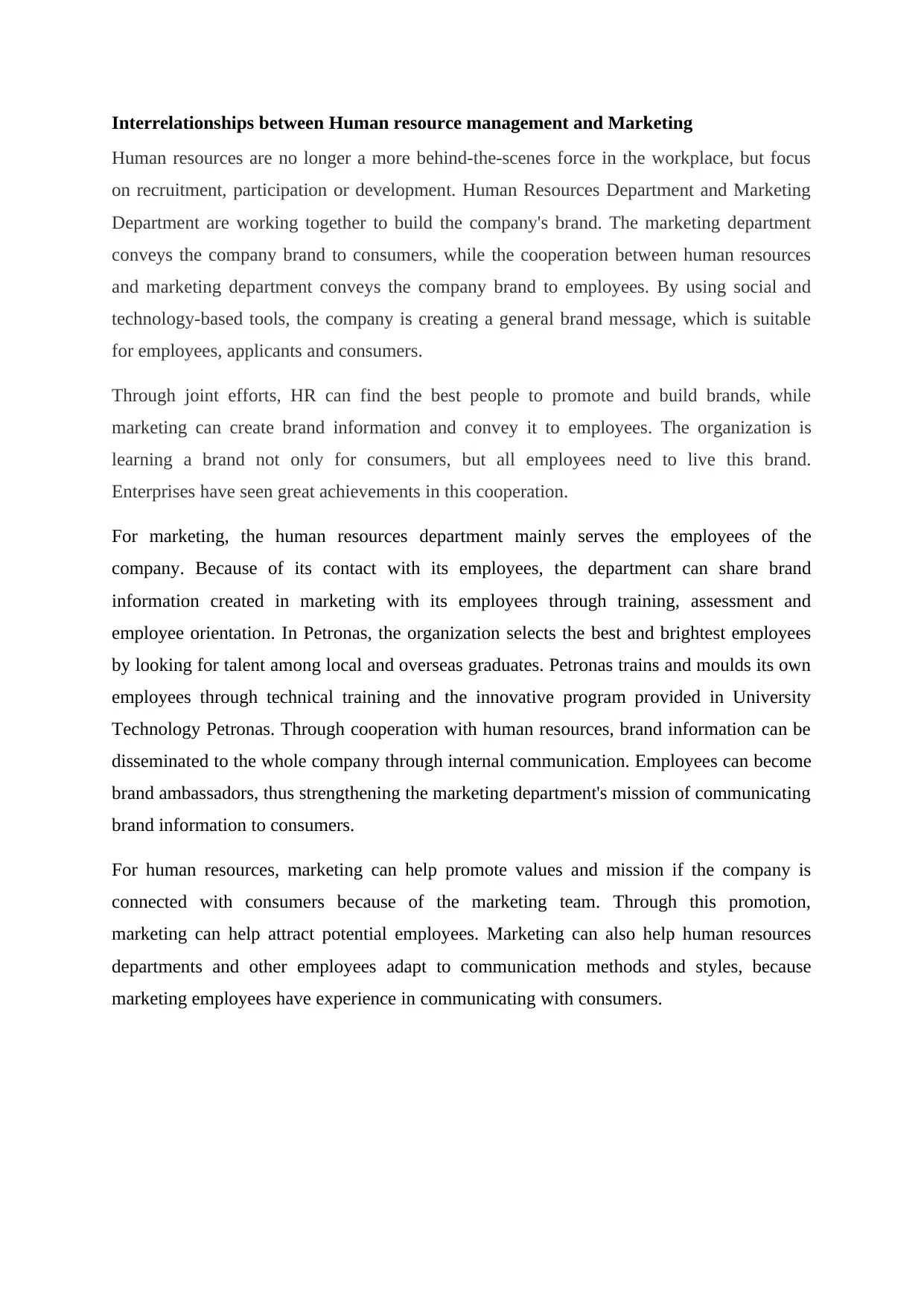
Interrelationships between Human resource management and Marketing
Human resources are no longer a more behind-the-scenes force in the workplace, but focus
on recruitment, participation or development. Human Resources Department and Marketing
Department are working together to build the company's brand. The marketing department
conveys the company brand to consumers, while the cooperation between human resources
and marketing department conveys the company brand to employees. By using social and
technology-based tools, the company is creating a general brand message, which is suitable
for employees, applicants and consumers.
Through joint efforts, HR can find the best people to promote and build brands, while
marketing can create brand information and convey it to employees. The organization is
learning a brand not only for consumers, but all employees need to live this brand.
Enterprises have seen great achievements in this cooperation.
For marketing, the human resources department mainly serves the employees of the
company. Because of its contact with its employees, the department can share brand
information created in marketing with its employees through training, assessment and
employee orientation. In Petronas, the organization selects the best and brightest employees
by looking for talent among local and overseas graduates. Petronas trains and moulds its own
employees through technical training and the innovative program provided in University
Technology Petronas. Through cooperation with human resources, brand information can be
disseminated to the whole company through internal communication. Employees can become
brand ambassadors, thus strengthening the marketing department's mission of communicating
brand information to consumers.
For human resources, marketing can help promote values and mission if the company is
connected with consumers because of the marketing team. Through this promotion,
marketing can help attract potential employees. Marketing can also help human resources
departments and other employees adapt to communication methods and styles, because
marketing employees have experience in communicating with consumers.
Human resources are no longer a more behind-the-scenes force in the workplace, but focus
on recruitment, participation or development. Human Resources Department and Marketing
Department are working together to build the company's brand. The marketing department
conveys the company brand to consumers, while the cooperation between human resources
and marketing department conveys the company brand to employees. By using social and
technology-based tools, the company is creating a general brand message, which is suitable
for employees, applicants and consumers.
Through joint efforts, HR can find the best people to promote and build brands, while
marketing can create brand information and convey it to employees. The organization is
learning a brand not only for consumers, but all employees need to live this brand.
Enterprises have seen great achievements in this cooperation.
For marketing, the human resources department mainly serves the employees of the
company. Because of its contact with its employees, the department can share brand
information created in marketing with its employees through training, assessment and
employee orientation. In Petronas, the organization selects the best and brightest employees
by looking for talent among local and overseas graduates. Petronas trains and moulds its own
employees through technical training and the innovative program provided in University
Technology Petronas. Through cooperation with human resources, brand information can be
disseminated to the whole company through internal communication. Employees can become
brand ambassadors, thus strengthening the marketing department's mission of communicating
brand information to consumers.
For human resources, marketing can help promote values and mission if the company is
connected with consumers because of the marketing team. Through this promotion,
marketing can help attract potential employees. Marketing can also help human resources
departments and other employees adapt to communication methods and styles, because
marketing employees have experience in communicating with consumers.
Paraphrase This Document
Need a fresh take? Get an instant paraphrase of this document with our AI Paraphraser
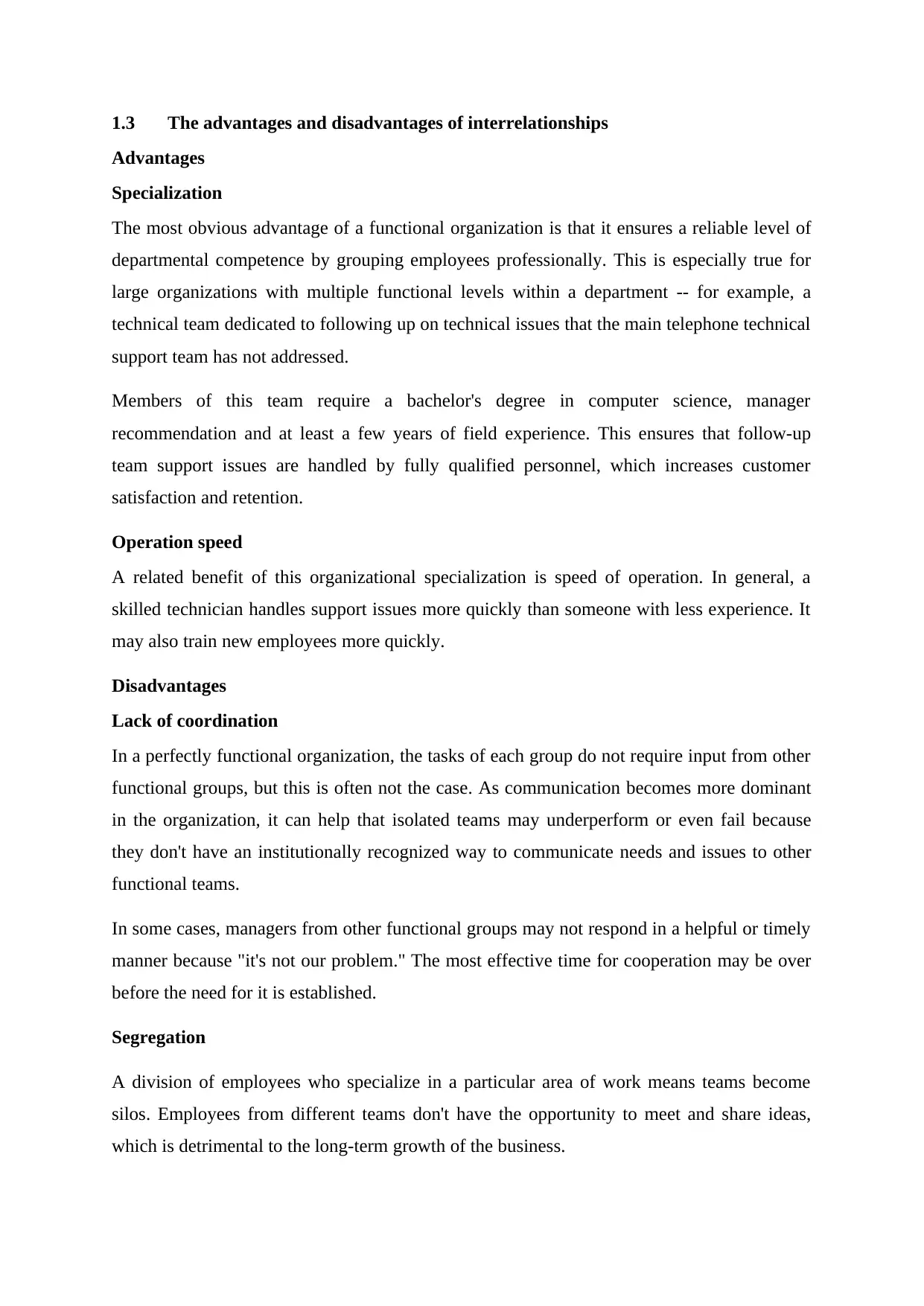
1.3 The advantages and disadvantages of interrelationships
Advantages
Specialization
The most obvious advantage of a functional organization is that it ensures a reliable level of
departmental competence by grouping employees professionally. This is especially true for
large organizations with multiple functional levels within a department -- for example, a
technical team dedicated to following up on technical issues that the main telephone technical
support team has not addressed.
Members of this team require a bachelor's degree in computer science, manager
recommendation and at least a few years of field experience. This ensures that follow-up
team support issues are handled by fully qualified personnel, which increases customer
satisfaction and retention.
Operation speed
A related benefit of this organizational specialization is speed of operation. In general, a
skilled technician handles support issues more quickly than someone with less experience. It
may also train new employees more quickly.
Disadvantages
Lack of coordination
In a perfectly functional organization, the tasks of each group do not require input from other
functional groups, but this is often not the case. As communication becomes more dominant
in the organization, it can help that isolated teams may underperform or even fail because
they don't have an institutionally recognized way to communicate needs and issues to other
functional teams.
In some cases, managers from other functional groups may not respond in a helpful or timely
manner because "it's not our problem." The most effective time for cooperation may be over
before the need for it is established.
Segregation
A division of employees who specialize in a particular area of work means teams become
silos. Employees from different teams don't have the opportunity to meet and share ideas,
which is detrimental to the long-term growth of the business.
Advantages
Specialization
The most obvious advantage of a functional organization is that it ensures a reliable level of
departmental competence by grouping employees professionally. This is especially true for
large organizations with multiple functional levels within a department -- for example, a
technical team dedicated to following up on technical issues that the main telephone technical
support team has not addressed.
Members of this team require a bachelor's degree in computer science, manager
recommendation and at least a few years of field experience. This ensures that follow-up
team support issues are handled by fully qualified personnel, which increases customer
satisfaction and retention.
Operation speed
A related benefit of this organizational specialization is speed of operation. In general, a
skilled technician handles support issues more quickly than someone with less experience. It
may also train new employees more quickly.
Disadvantages
Lack of coordination
In a perfectly functional organization, the tasks of each group do not require input from other
functional groups, but this is often not the case. As communication becomes more dominant
in the organization, it can help that isolated teams may underperform or even fail because
they don't have an institutionally recognized way to communicate needs and issues to other
functional teams.
In some cases, managers from other functional groups may not respond in a helpful or timely
manner because "it's not our problem." The most effective time for cooperation may be over
before the need for it is established.
Segregation
A division of employees who specialize in a particular area of work means teams become
silos. Employees from different teams don't have the opportunity to meet and share ideas,
which is detrimental to the long-term growth of the business.
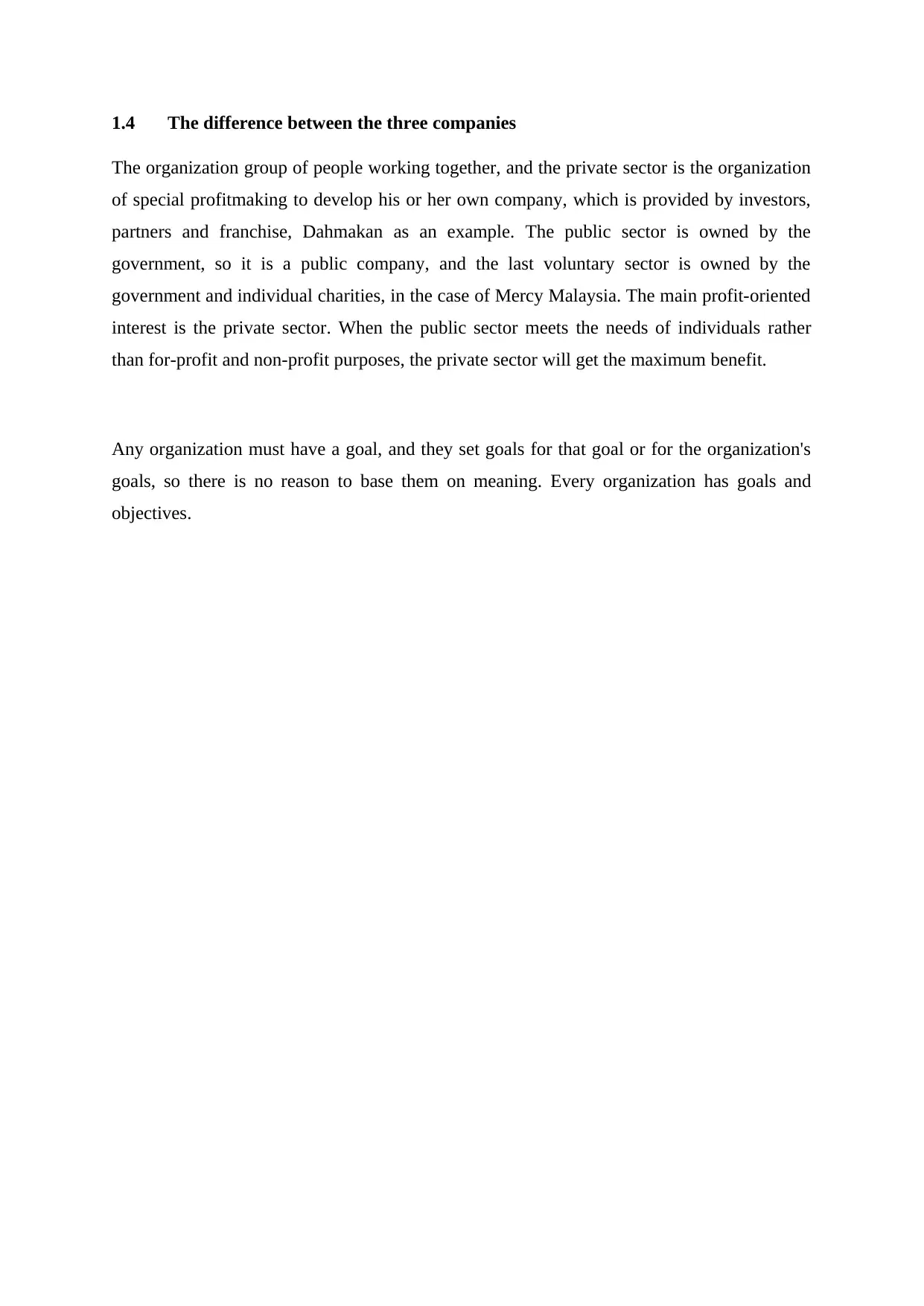
1.4 The difference between the three companies
The organization group of people working together, and the private sector is the organization
of special profitmaking to develop his or her own company, which is provided by investors,
partners and franchise, Dahmakan as an example. The public sector is owned by the
government, so it is a public company, and the last voluntary sector is owned by the
government and individual charities, in the case of Mercy Malaysia. The main profit-oriented
interest is the private sector. When the public sector meets the needs of individuals rather
than for-profit and non-profit purposes, the private sector will get the maximum benefit.
Any organization must have a goal, and they set goals for that goal or for the organization's
goals, so there is no reason to base them on meaning. Every organization has goals and
objectives.
The organization group of people working together, and the private sector is the organization
of special profitmaking to develop his or her own company, which is provided by investors,
partners and franchise, Dahmakan as an example. The public sector is owned by the
government, so it is a public company, and the last voluntary sector is owned by the
government and individual charities, in the case of Mercy Malaysia. The main profit-oriented
interest is the private sector. When the public sector meets the needs of individuals rather
than for-profit and non-profit purposes, the private sector will get the maximum benefit.
Any organization must have a goal, and they set goals for that goal or for the organization's
goals, so there is no reason to base them on meaning. Every organization has goals and
objectives.
⊘ This is a preview!⊘
Do you want full access?
Subscribe today to unlock all pages.

Trusted by 1+ million students worldwide
1 out of 24
Related Documents
Your All-in-One AI-Powered Toolkit for Academic Success.
+13062052269
info@desklib.com
Available 24*7 on WhatsApp / Email
![[object Object]](/_next/static/media/star-bottom.7253800d.svg)
Unlock your academic potential
Copyright © 2020–2025 A2Z Services. All Rights Reserved. Developed and managed by ZUCOL.





